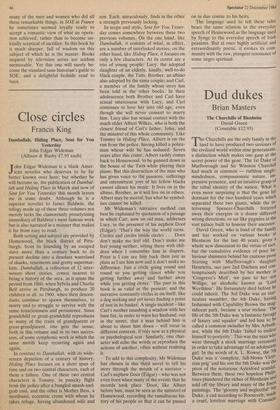Close circles
Francis King
Damballah, Hiding Place, Sent for You Yesterday John Edgar Wideman (Allison & Busby £7.95 each) Tohn Edgar Wideman is a black Amer- ican novelist who deserves to be far better known over here; but whether he will become so, the publication of Dambal- lah and Hiding Place in March and now of Sent for You Yesterday this month leaves me in some doubt. Although he is a superior novelist to James Baldwin, the trilogy made up of these three volumes not merely lacks the clamorously proselytising immediacy of Baldwin's most famous work but is also narrated in a manner that makes it far from easy to read.
Both setting and subjeCt are provided by Homewood, the black district of Pitts- burgh, from its founding by an escaped slave more than a century back to its present decline into a desolate wasteland of shacks, tenements and grotty supermar- kets. Damballah, a collection of 12 inter- woven short stories, comes nearest to being a history of the area, as it spans the period from 1860, when Sybela and Charlie Bell arrive in Pittsburgh, to produce 20 children in all, to 1960, when their descen- dants continue to spawn themselves, to marry and to struggle to survive with the same tenaciousness and persistence. Since grandchild or great-grandchild reproduces so many of the traits of grandparent or great-grandparent, one gets the sense, both in this volume and in its two succes- sors, of some symphonic work in which the same motifs keep recurring again and again.
In contrast to Damballah, with its wide- screen depiction of a century of history, Hiding Place focuses on a short span of time and on two central characters, each of them a failure. One of these two central characters is Tommy, in panicky flight from the police after a bungled smash-and- grab raid, and the other is Mother Bess, a moribund, eccentric crone with whom he takes refuge, having abandoned wife and son. Each, miraculously, finds in the other a strength previously lacking.
In scope and style, Sent for You Yester- day comes somewhere between these two previous volumes. On the one hand, like Damballah, it consists of what, in effect, are a number of interlinked stories; on the other hand, like Hiding Place, it focuses on only a few characters. At its centre are a trio of young people: Lucy, the adopted daughter of an elderly, kindly, well-to-do black couple, the Taits; Brother, an albino also adopted by the same couple; and Carl, a member of the family whose story has been told in the other books. In their adolescence both Brother and Carl have sexual intercourse with Lucy, and Carl continues to love her into old age, even though she will never consent to marry him. Lucy also has sexual contact with the much older Albert Wilkes, who is both the closest friend of Carl's father, John, and the minstrel of this whole community. Like Tommy in Hiding Place, Albert is on the run from the police, having killed a police- man whose wife he has seduced. Seven years after this crime, Albert rashly comes back to Homewood, to be gunned down in the house of the Taits while playing their piano. But this destruction of the man who has given voice to the passions, sufferings and intermittent joys of his fellow blacks cannot silence his music. It lives on in the albino, Brother, as it will live on in others. Albert may be mortal, but what he symbol- ises cannot be killed.
Mr Wideman's narrative method can best be explained by quotation of a passage in which Carl, now an old man, addresses Lucy, in the presence of his nephew Doot (Edgar): 'That's the way the world turns. Circles and circles inside circles . . . Doot don't make me feel old. Don't make me feel young neither, sitting there with chil- dren when I remember him in diapers. Point is I can see him back then just as plain as I see him now and it don't make no difference. Just a circle going round and round so you getting closer while you getting further away and further away while you getting closer.' The past in this book is as valid as the present; and the narrative constantly circles in on itself, like a dog seeking and yet never finding a point of rest in its basket. A single incident – like Carl's mother smashing a window with her bare fist, in order to warn her husband, out in the street, that a man behind him is about to shoot him down – will recur in different contexts, if only now as a physical or psychological scar. Similarly, one char- acter will echo the words or reproduce the actions of another, often without realising it.
To add to this complexity, Mr Wideman has chosen in this third novel to tell his story through the mouth of a narrator Carl's nephew Doot (Edgar) – who was not even born when many of the events that he records took place. Doot, like Albert before him, must be seen as the minstrel of Homewood, recording the tumultuous his- tory of his people so that it can be passed
on in due course to his heirs.
The language used to tell these tales bears the same relation to the everyday speech of Homewood as the language used by Synge to the everyday speech of Irish peasants. But at once highly artificial and extraordinarily poetic, it evokes its com- munity with the raw, plangent resonance of some negro spiritual.






































































 Previous page
Previous page